The Northern Territory is situated in northern-central Australia. Its capital city is Darwin.
- The history of the Northern Territory
- The Northern Territory by numbers
- Territory flag and emblems
- Northern Territory attractions
- Northern Territory fast facts
- References
The history of the Northern Territory
Indigenous history
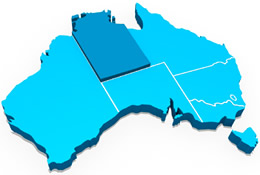
Before European settlement, there were hundreds of thousands of Aboriginal people living in the Northern Territory, speaking hundreds of languages. The Yolngu came from Arnhem Land and the Arrernet, Warlpiri and Pitjantatjara were from central Australia. Hundreds of years ago, Australian Aboriginals in the Northern Territory established trade with the Makassan from Indonesia who travelled to Australia to harvest sea cucumbers.
Many Aboriginal cultures still exist in the Northern Territory, such as the Larrakia people, who are sometimes called the ‘Saltwater People’. They are the traditional custodians of the land and waters surrounding Darwin. Over 80 Aboriginal languages are still spoken in the Northern Territory. Around half of the land in the Northern Territory is owned by Aboriginal people, including famous national parks suck as Kakadu and Uluru-Kata Tjuta, which are leased back to the government.

European arrival
The first attempt to settle in northern Australia (which was a part of New South Wales at the time) occurred in 1824, followed by later attempts in 1829 and 1849. Settling the area was difficult due to its isolation, limited supplies and harsh conditions which often resulted in starvation, illness and failure. In the early 1860s northern Australia was taken under the control of the South Australian Government.
Finally, in 1869 a northern settlement was successfully established. It was named Darwin, after Charles Darwin, and was founded by Captain John Lort Stokes. Following this success, Alice Springs was founded to the south in 1871. The 1870s saw the discovery of gold in the Northern Territory. Over the years, many substances have been mined in the Northern Territory including copper, tin, manganese, wolfram, mica, bauxite, uranium, oil and gas.
On 1 January 1911, the Northern Territory separated from South Australia and became a part of the Commonwealth of Australia.

The Northern Territory by numbers*
- The population of the Northern Territory is 245,000.
- Darwin (the capital city of the Northern Territory) has an estimated population of 145,000 people.
- 51.7 percent of people in the Northern Territory are male and 48.3 percent are female.
- Aboriginal and Torres Strait Islanders account for 25.5 percent of the Northern Territory’s population.
- The top five ancestries for people in the Northern Territory are: Australian, English, Australian Aboriginal, Irish and Scottish.
- The top five languages (other than English) spoken in the Northern Territory are: Kriol, Djambarrpuyngu, Greek, Tagalog and Warlpiri.
- The top five countries of birth (other than Australia) for people in the Northern Territory are: England, Philippines, New Zealand, India and Greece.
- The Northern Territory has a total area of 1,349,129 km2 which accounts for around 17.5 percent of Australia’s total land mass.
- The ‘Top End’ of the Northern Territory has a coastline that extends more than 13,500 km.
* correct at 2016 Census
Territory flag and emblems
Flag
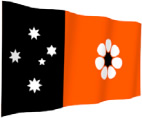
The Northern Territory’s flag was first raised on 1 July 1978. It uses the colours black, white and ochre. A stylised Sturt’s Desert Rose appears against an ochre background. On the left-hand side of the flag is a white Southern Cross against a black background. The seven petals of the Sturt’s Desert Rose represent the six Australian states and the Northern Territory.
Coat of Arms
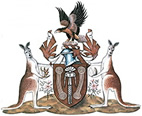
The Northern Territory’s Coat of Arms depicts all of the Territory’s floral and faunal emblems: the Sturt’s Desert Rose, two Red Kangaroos and a Wedge-tailed Eagle. The two Red Kangaroos hold shells and support a shield. The shield depicts a drawing of a woman in a style influenced by Arnhem Land rock art. The designs surrounding the woman are simplified Churunga, map-like drawings of campsites joined by paths. The Wedge-tailed Eagle holds an Aboriginal Tjurunga stone on top of a helmet. The helmet signifies the Northern Territory’s role in war. Between the shield and either of the kangaroos are Sturt’s Desert Roses.
Emblems
The Northern Territory’s faunal emblems are the Wedge-tailed Eagle and the Red Kangaroo. The Wedge-tailed Eagle has an average wingspan of 2.5 metres, making it Australia’s largest raptor. The Red Kangaroo is Australia’s largest marsupial. Males can grow up to 2 metres in height and weigh over 75 kilograms.
The Northern Territory’s floral emblem is the Sturt’s Desert Rose. The Sturt’s Desert Rose has been known by other names including the Darling River Rose, Cotton Rosebush and Australian Cotton.
Northern Territory attractions
The Northern Territory is home to breathtaking and varied landscapes as well as important Indigenous landmarks and sites, such as the famous Uluru (Ayers Rock) and the remarkable Kata Tjuta (the Olgas). Some other famous attractions are detailed below.
Kakadu National Park
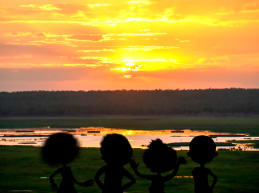
Kakadu National Park is a World Heritage-listed National Park. Spreading over 19,804 km2, Kakadu is also Australia’s biggest national park. It contains diverse landscapes from rainforest, to rugged rock formations, to wetlands, waterfalls, waterholes and billabongs.
The Bininj/Mungguy are the traditional custodians of Kakadu. According to Bininj/Mungguy belief, the Rainbow Serpent created Kakadu’s magnificent valleys and waterholes.
One quarter of Australia’s freshwater fish species live in Kakadu, as do over one third of Australia’s bird species. Kakadu is abundant with native wildlife such as crocodiles, barramundi, goannas, frill-necked lizards, water pythons, wallabies, magpie geese, brolgas, jabirus and sea eagles.
Darwin Harbour

Darwin Harbour has seen many ups and downs. It has been struck by cyclones and suffered wartime damage.
The first wharf in the harbour was called Railway Jetty and was built in the mid 1880s. A steam engine called the Sandfly ran along the wharf carrying goods. This wharf suffered from cyclone damage, so a new wharf, called the Town Wharf was constructed and completed in 1903.
On 15 February 1942, a Japanese bombing raid sunk eight of the harbour’s 47 ships, destroying the wharf and killing many people. The Town Wharf’s replacement, the modern-day Stokes Hill Wharf, was completed in 1956.
Today, the harbour is home to many attractions such as the World War II Oil Storage Tunnels, the Deckchair Cinema, the Waterfront Lagoon, Government House and the Darwin Convention Centre.
Northern Territory fast facts
- The lush, tropical north of the Northern Territory is often called the ‘Top End’, while the desert outback of central Australia is referred to as the ‘Red Centre’.
- The Northern Territory’s Finke River is the oldest river system in the world, with parts possibly dating as far back as 340 million years.
- Stokes Hill in Darwin is named after Captain John Lort Stokes. It is home to a Larrakia spiritual ancestor called Chinute Chinute who sometimes appears as a Tawny Frog Mouth.
- The devastating tropical Cyclone Tracy hit Darwin on Christmas morning 1974. The cyclone killed 65 people and damaged the majority of Darwin’s buildings and infrastructure. Following the destruction, Darwin’s building codes and disaster plans were heavily reviewed, to replace flimsy buildings with sturdy ones and enforce strict, life-saving disaster plans.
- The very talented and internationally renowned singer, songwriter and actor Jessica Mauboy was born in Darwin in 1989.
- Uluru (Ayers Rock) has been around for millions of years and stands about 348 metres high. Interestingly, it is thought that the bulk of the rock is underground, extending down 2.5 kilometres.
- Between 1860 and 1907 tens of thousands of one hump camels were imported into Australia to help people pioneer the harsh, dry conditions. Today, around 200,000 wild camels roam the Northern Territory.
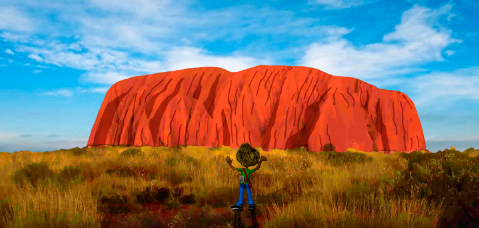
References
The following links will direct you to the homepage of the websites used as references for this topic.
- Australian Bureau of Statistics: www.abs.gov.au
- Northern Territory Government: www.nt.gov.au
- Kakadu National Park: www.kakadu.com.au




